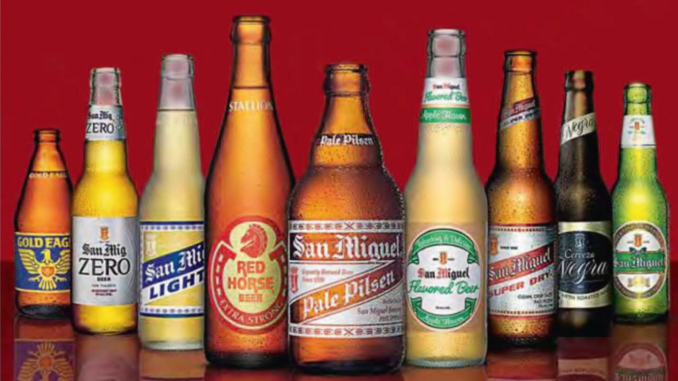
Unknown perhaps to many, San Miguel Corp. is the Philippines’ largest food company. Its annual food and beverage sales will likely hit P280 billion this year. Its annual profits from food and beverage are about P30 billion. Margins are high, about 20%, in an industry that is very competitive and where margins are usually single digit.
San Miguel is also the country’s largest retail organization. Its 95-percent-owned food and beverage subsidiary, San Miguel Food and Beverage, Inc. (SMFB) has over 400,000 beer outlets, 141,000 spirits outlets, and 130,000 retail outlets for foods. It has 1,200 chicken stations, 650 Monterey meat shops, and 530 Kambal Pandesal stores. SMFB is also the biggest food service provider in the archipelago.
Listed in the stock market, SMFB is valued at P585 billion. That makes it the country’s largest food company in market capitalization.
So largest food company in sales, largest in profits, largest in market cap and largest in retail network. Awesome. Nobody comes close.
This is why if there is any company that can solve the Philippines’ serious rice shortage and shortages of other food items like fish, vegetables and meat, it is San Miguel. This makes San Miguel such a good investment.
SMC President Ramon S. Ang has offered to ramp up rice supply by being allowed to import rice and sell it at moderate prices. He also vows to increase rice production by organizing the country’s rice farmers as San Miguel’s contract growers for rice, providing them with seeds, fertilizers, credit, technical supervision, warehousing and milling, guaranteed market and pricing. The idea will put rice cartels out of business and put an end to predatory speculation on the price and supply of the staple food.
The rate of increase in prices or inflation is reaching ten-year highs (probably more than 6% per year by this August). Why? Because there is not enough food supply. Food is 50 of every 100 pesos of expenditure of some 24 million households in the Philippines. Of the 50 pesos for food, rice accounts for 20 pesos. The poor among us spend much more on food, as high as 60 pesos for every 100 of expenditure.
RSA’s offer could be the greatest poverty alleviation program ever done. Poverty is question of purchasing power. If the poor could buy more food at lower prices, they will have enough money to buy other essentials – clothes, education, health care, entertainment. It is called quality of life.
You want to buy into San Miguel’s food business? You can do now that San Miguel is doing a follow-on IPO. SMFB is making a follow-on IPO by selling 887 million common shares at P140 per share, plus another 133 million shares to cover over allotment. The 887 million shares are valued at P124.18 billion.
(Disclosure: I don’t buy shares of companies I write about).
Briefly, here is why SMFB is a good “buy” stock:
–SMFB the largest consumer name in the Philippines by sales, net income, and market capitalization.
–Huge capacity additions will drive long-term sustainable growth.
–SMFB’s San Miguel Brewery (SMB) should be valued at a premium above its peers given its uncontested market leadership, proven track record, strong brand equity, and high profitability. SanMig is one of Asia’s oldest beers and is globally famous. SMC is the original PH multinational.
With the re-IPO, SMFB has incorporated back into the business its beer operation under San Miguel Brewery.
–Post consolidation, SMFB earnings will be more resilient and less volatile on the back of the structural change in sales mix.
–SMFB will be a predominantly commodities-driven business into a branded food and beverage powerhouse.
–Higher revenue contribution from the branded business will enhance margins and result in lower earnings volatility.
With SMFB’s IPO, San Miguel is parlaying the strength of the Philippine economy and the conglomerate’s leadership, strength, and marketing prowess in its old businesses—beer, beverages and foods. SMFB is spending P86.6 billion to expand—P5.3 billion for beer and P81.3 billion for food.
The P86.6 billion beer and food expansion is 12% of SMC’s P742 billion three-year capacity expansion, the largest in its 128-year history.
The P742 billion expansion makes San Miguel the single largest corporate investor in the Philippines, bar none. SMC, of course, contributes 5.2% to the annual production of goods and services or GDP.
The P742 billion does not include the P750 billion cost of a new airport San Miguel will build in Bulacan with government approval. The airport opens six years from the time construction is started, with four runways and capacity to serve 100 million passengers per year.
Of the P81.3 billion for food capex, P30.54 billion will build 11 feed mills, P10.887 billion will go to the expansion of its branded value added foods, P10.887 billion for nine new integrated poultry processing plants, P8.55 billion for flour milling and grain terminal expansion, P6.9 billion for a corn dryer, silos and warehouse; P1.1 billion for a slaughterhouse, and P469 million for a poultry breeding farm.
In terms of earnings before interest, taxes, and depreciation or EBITDA, SMFB makes close to $1 billion. EBITDA margin is 20%—very high for a food and beverage company in an industry where margins are single digits. SMFB EBITDA rises by an average of 15% per year.
SMFB has three operating divisions – beer, spirits, and food. All are booming businesses, enabling San Miguel to generate substantial revenues and bigger and bigger profits.
The economy has been consumer-driven for the past 10 years. Household expenditures account for 73% of the annual output of goods and services (Gross Domestic Product or GDP). If you add government spending, consumer spending accounts for 84% of GDP.
Filipinos should be spending more. The savings rate is 29.8% Based on a GDP of P17 trillion, 29.8% translates into P5 trillion money looking for goods and services to buy or outlets to invest in.



